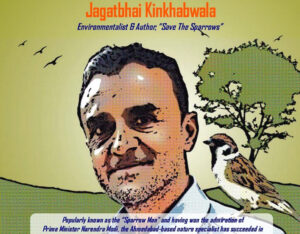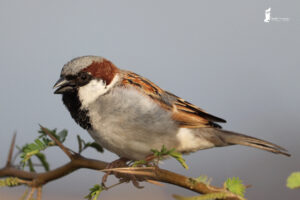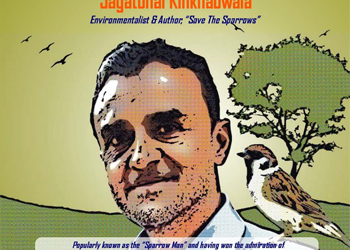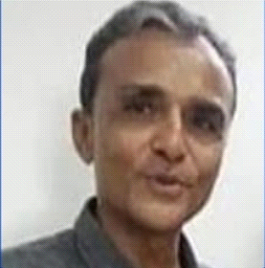Applied Jainism – is a social platform to collaborate & discuss contemporary issues on sustainable co-existence (Parasparopagraho Jīvānām / परस्परोपग्रहो जीवानाम् where the principle of Jain philosophy & spirituality can guide us and become the torch bearer in the modern age. www.appliedjainism.in
Jainavenue is a medium to serve the spiritual path of Jainism
Let’s bring back the house sparrow home again – Team Applied Jainism
December, 2021 by Jagat Kinkhabwala - Team Applied Jainism
According to Jainism, humans are not separate from other life/ environment, for the existence of human life and every other life, the coordination of environment and coexistence is a complementary and integral part of each other.
Treating all living beings with restraint is non-violence. Wrong conduct towards any life form living on earth, in water, vegetation and air; by thoughts, words or action, is immoral and considered as violence.
India is a tropical region and is rich in biodiversity. There are 960 species of birds and 15000 types of trees in India. But in the garb of development and in the race of humans for material gains, the environment is being destroyed at an alarming rate in all four directions, which is a danger bell not only for the existence of other living beings but also for human beings as well.
The existence of the earth has been there for millions of years and in contrast the existence of humans has been there for few thousand years only, but our treatment towards the earth and its beings is as if we own the universe and are its master. With the advent of industrial revolution 110 years ago, materialistic development is happening at a very fast pace and because of that every living being, whether small or big, is being affected, or it can be said that humans are destroying it.

House sparrow / Passer domesticus
Length: 6 inches – 15 cm / Wingspan: 6 inches – 15 cm / Weight: up to 30 gm. / Life span: 6 years
There are 6 species of sparrows found in India. At one point of time, house sparrow was considered as a family member, but now it is disappearing from our homes and its numbers are decreasing very fast. However, we can bring back our sparrows into our home again with small efforts by all of us.
The house sparrow is a common bird that lives around the human habitation. It is one of the 17 common birds found all over India. At present, the condition of existence is getting worse for every single bird and all small and big creatures.
Among the birds, the number of house sparrow have drastically reduced and are becoming extinct, which is a matter of great concern. In comparison to the rate of reduction in numbers of all these birds, the reduction in numbers of house sparrow is significantly fast, for which their genetic deficiency is a big reason. Unlike other birds, the house sparrow is incapable of building a nest to lay eggs. It always builds a nest inside the house or outside in a hole. From time immemorial, people have let it build a nest inside the house considering it to be a member of the family and providing it with grains for food. Usually house sparrow builds its nest behind the photo frame, on the shelf, in the gap between the pots or on the ceiling fan. This was a common site in each household and watching it there manifested a wonderful feeling of joy.
With the passage of time, in the run-of-the-mill life and the new lifestyle adopted by humans, such birds, butterflies and trees have no place, and to satisfy our own needs, humans have destroyed the things needed by such organism. Nests built by the birds are scattered in the name of cleanliness. There is no place for them to nest in the design or architecture of new buildings. There is no food or water available for them and the number of trees is also decreasing rapidly.
Before the female bird conceives, the male bird finds or builds a nest that is suitable to lay eggs. If this nest is destroyed, then the survival chances of eggs are negligible. In such hard times, they are forced to lay eggs anywhere they can find a place. At the time of the birth of the hatchling, caterpillars and insects are needed to feed them in the nest so that they become strong. At present, the use of pesticides has increased in the small garden or in the field, due to which the insects die and if such insects are fed to the chicks or the birds consume it themselves, they might also die. Air pollution, burning of garbage near the nest and noise pollution are some of the reasons that hinder the calls for mating during the breeding season and because of the increased appetite of a chick, there physical development is not achieved properly and it becomes the victim of malnutrition. Due to climate change, in the ever-increasing temperature and without trees, the magnificence of concrete jungle is increasing, and life has become challenging for the rest of the living beings.
The simple answer to increase the number of house sparrows in the midst of all these burning issues is to be practical and to find real-world solutions in all difficulties. Unlike earlier if we are not comfortable with nests inside the house then there are other ways to provide shelter to the birds. Make a nest from the leftover pieces of cardboard, wood chips or even a terracotta nest and hang it outside the house in a shaded area; the sparrow will find its way to the nest. Also keep tap water in a bowl, in the shaded area for it to drink. Put millet (75%) and rice (25%) in a terracotta dish or a bottle feeder. House sparrows consume 4 gm. of grains and drinks 2 to 4 teaspoon of water. This all can be arranged at a very minuscule expense and on a daily basis. This arrangement can also be done in the balcony of the flat or bungalow. The only thing to be kept in mind while putting up a nest is that there should not be an inlet of direct sunlight or the rain water from the nest’s entrance and should be placed at a height of 6 to 7 feet in a shaded area so that they don’t become prey to a cat. If only we could become more human!
Slowly, the sparrow first inspects the place to confirm that it is not built to imprison it and when it is comfortable then only it approaches the nest for grain and water. During the breeding season in summers, it collects required quantity of hay and straw for the nest at the time of conception. First the male finds the nest, the female approves it, then the male fills it with twigs, etc., on top of it the female spreads soft grass and lay eggs on it. It has been commonly experienced that this nest is used by the sparrows for many more years to come.
It lays 4 to 7 eggs in a nest, which gives a sense of immense happiness and satisfaction for all your contribution that made it a success. What a little expense and just five minutes of our daily time pays off! We just have to be patient till the sparrow spots the nest. Any work done with good spirit gives good results. Other birds will also take advantage of the grains and water, and the melodious sounds of all these birds will make the atmosphere around blissful.
All the animals and birds come to earth with a specific role to play. The insects and caterpillars that these sparrows eat have different kind of viruses in their body. When the sparrow eats it, the virus inside the body of an insect dies with it. Now if we consider that there are no sparrows that eat these insects, then the virus in their bodies become stronger because of which new diseases spread among other birds and animals and the chances of an epidemic increases. In today’s time, there are many such diseases which were never there before but have spread a lot in recent times. This is the contribution and importance of every living being and even being like a sparrow in maintaining the balance of nature and its ecosystem.
It is our moral duty to save this disappearing bird. It is a simple matter that by doing this other species of bird will also be benefited from the supply of grains and water and someday a small bird may occupy the nest. Their numbers will also increase. Your success will inspire others and more people will join the movement and the trend will be carried ahead. People will stop destroying the nests; an act of compassion will be done, and people will have the satisfaction of giving something back to the society. The spirit of coexistence will be stimulated in the human being and with sensitivity, the values will also increase, and the future of the coming generation will be bright.

Starting from the year 2008, the continuous efforts of me, my family and especially my wife Shilpa have paid off. Since the movement we started, more than 150,000 hatchlings have been born in the 1,25,000 nests we have provided free of cost, photographs, and videos of which have been documented and are successfully taking this task forward at a rapid pace.
We have penned the book “Save the Sparrow”, which has 4 editions and has been appreciated by Honourable Prime Minister Shri Narendra Modiji in his famous “Mann Ki Baat” program and has also written a letter to the effect that personally we feel overwhelmed.
Articles are being published on regular basis in the media regarding this issue. For so many years, a lot of awareness is spreading through TV interviews and articles on social media and sessions taken in various organizations. More and more people are joining, and we hope you will also join in this endeavour of saving the sparrows.
You need more than one glance to live Jainism in the true sense! Let’s make life meaningful together. Be an inspiration to do something for someone else and earn blessings.
The photographs will help you decorate more beautifully.
Love-Learn-Conserve
About Author
He is an accomplished Environment Management Consultant, a preservationist and CSR Consultant. He has been leading and managing projects for corporates in the field of agriculture, organic farming, water harvesting, commercial plantation and waste recycling. Since 2008 he has been working on “Save the Sparrows” project and he has received appreciation by many including Honourable Prime Minister Narendra Modi. He says “Nature is my passion and to live with passion is my nature.



I don’t think the title of your article matches the content lol. Just kidding, mainly because I had some doubts after reading the article.